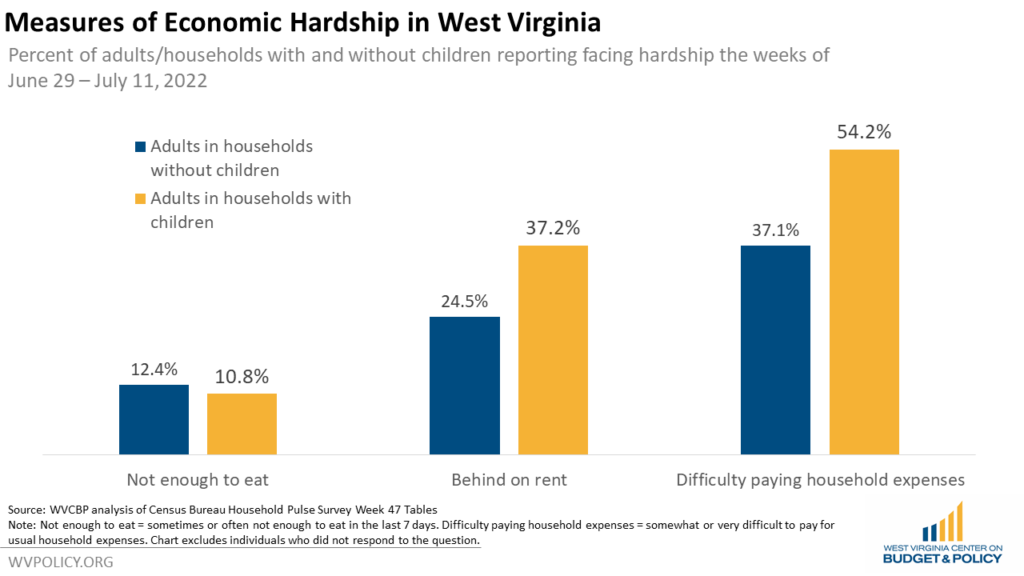As more West Virginians became vaccinated, and the American Rescue Plan (ARP) supported the economy, West Virginia began to see strong improvements in 2021. But new COVID variants threatened the recovery, and the impact of the ARP has begun to fade. And the depth of the downturn means that West Virginia still has a long way to go before the economy has fully recovered.
This page tracks important state-level indicators of how West Virginia’s economy is performing. It will be updated throughout the crisis as new data becomes available.
Employment in West Virginia
The following charts track the monthly change in nonfarm employment as well as overall nonfarm employment levels in West Virginia from the Bureau of Labor Statistics, Current Employment Statistics estimates. The pandemic triggered a historic level of job loss in West Virginia, and the state has yet to fully recover. Stimulus checks and enhanced unemployment benefits helped jumpstart and sustain the recovery, but those measures have now ended. New proposals in the Build Back Better plan would spur a stronger recovery and create the conditions for a healthy job market in the long term.
Source: WVCBP analysis of Bureau of Labor Statistics, Current Employment Statistics data
Source: WVCBP analysis of Bureau of Labor Statistics, Current Employment Statistics data
Unemployment Insurance
New unemployment insurance (UI) claims are a nearly real-time indicator of labor market health, while continued unemployment claims help indicate how pervasive joblessness is, as individuals ask for additional weeks of benefits. Federally funded programs provided additional weeks of benefits and expanded eligibility to workers not eligible for regular state unemployment benefits, but West Virginia ended those programs in June of 2021.
Source: U.S. Department of Labor
Source: U.S. Department of Labor
Supplemental Nutrition Assistance Program
Like unemployment insurance, SNAP responds quickly to changes in the economy, and so it is also an important real time indicator for how West Virginians are faring. Because it is targeted to people with net incomes below the poverty line ($26,200 for a family of four), it is particularly helpful for knowing how West Virginians with low incomes are faring.
The chart below tracks the number of households enrolled in the SNAP program in West Virginia by month.
Note: Beginning in January 2022, the Bureau for Family Assistance switched to using a new data source to generate the monthly Secretary’s Reports in order to be more consistent with data reported elsewhere by the Bureau. Any apparent discrepancies between older reports and reports generated starting in January 2022 may be due to this change.
Source: West Virginia Bureau for Children and Families Secretary’s Report
Monthly General Revenue Collections
The impact of social distancing and state shut down orders had a major impact state tax collections. However, large amounts of federal stimulus helped prevent large declines in West Virginia’s General Revenue Fund which protected investments in vital services and and helped the state respond to the crisis. However, the state’s current surpluses are largely the result of low revenue estimates, which prevent the state from making necessary investments through the normal budgeting process.
The graph below tracks monthly General Revenue collections compared to the same month the previous year.
Source: WVCBP analysis of West Virginia State Budget Office data
Another way to look at the state’s revenue situation is to compare actual revenue collections to the estimated collections for that month. West Virginia, like all states, must balance it’s budget. Any revenue shortfall must be balanced. The graph below tracks monthly General Revenue collections compared to estimated collections.
Source: WVCBP analysis of West Virginia State Budget Office data
*Note* June 2020 revenues in these charts do not include the $57 million federal reimbursement that is included in the official revenue report
Department of Corrections
People incarcerated in the nation’s prisons and jails are at particular risk from the virus, due to lack of proper social distancing. In West Virginia, concern over a potential outbreak in the state’s correctional facilities has led to a review of cases and identifying candidates for early release and parole, in an attempt to reduce the prison population, and prevent the spread of the virus.
The graph below tracks the average daily prison population in West Virginia’s correctional facilities.
Source: WVCBP analysis of WV Dept. of Corrections and Rehabilitation data
Economic Hardship
The COVID downturn and continuing recovery have made it difficult for many West Virginians to meet basic needs. While federal programs helped to keep an estimated 301,000 West Virginians out of poverty in 2021, many of those programs such as the expanded child tax credit, special unemployment insurance programs and stimulus checks have ended. With new variants of COVID-19 continuing to disrupt the progress of the recovery, West Virginians will continue to struggle to stay current on rent, keep food on the table and afford everyday necessities. The chart below shows three measures of economic hardship from the most recent Census Household Pulse Survey.
